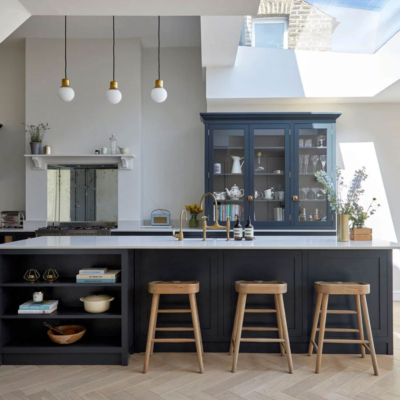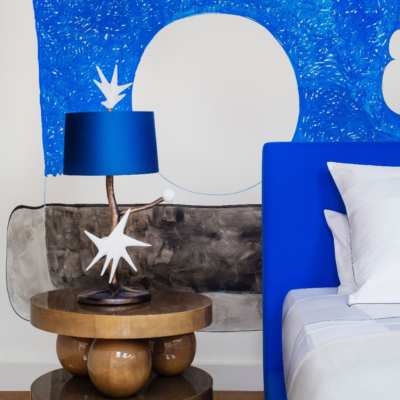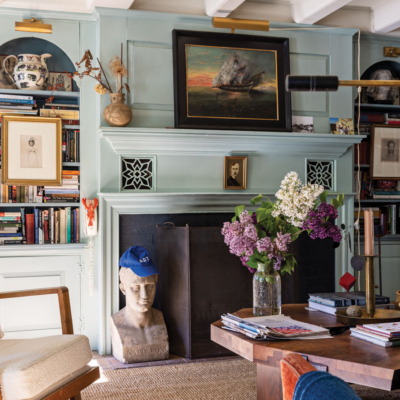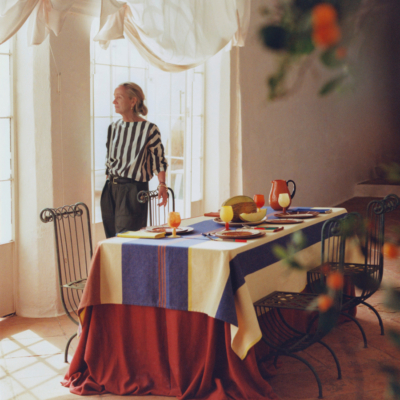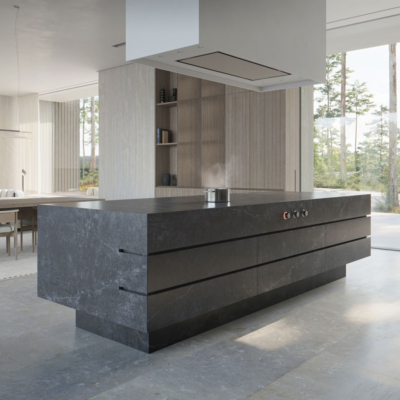Interior designer Robert Kime is a genius at discovering and mixing fabrics, objects and antiques to create a layered, comfortable country house mood, even in his city home …
For interior designer Robert Kime, every room starts with a rug. “You have to start with something,’” he says, “and I always think a carpet is the easiest thing.” A rug can define a space, break up a large room or highlight a particular area – it can play a number of roles. That worn rug, though, seems fitting, representing life and history, and providing a platform for his collection of fascinating objects.

When Robert moved into the flat, he installed new fireplaces and radically opened up spaces. Robert Kime Savernake chairs in the sitting room are upholstered in his ‘Tynemouth Ticking’ fabric. The mirror is 18th-century Italian.
With a background in antiques and a passion for history, it is unsurprising that Robert’s London flat is full of interesting things, from a rare screen covered in Chinoiserie paper that he picked up at an auction for just a few pounds to William Wordsworth’s own leather chair, which sits behind the desk in his study. As a child, Robert, who started collecting coins at the age of five, used to spend hours in the garden shed. It was piled high with “junk” left behind by relatives who had gone to India. “It was my idea of heaven – I used to muck about and play, and used to decorate it,” he says. “This was probably when I was six or seven – so that’s where I learnt how to do it. There were lots of pots, carpets, curtains – in those days, you didn’t sell it, you stored it.”
He left home at 16, and later, while reading history at Oxford, was forced to sell the family’s furniture, including the shed’s contents, due to financial hardship. “I learnt the hard way what everything was worth, which was very important to me,” he says. “I made a lot of mistakes – it wasn’t easy, but we did it.”

Moroccan decorated shelf, lined with hookah bases, hangs above the doorway leading from the study to Robert’s favourite room, the drawing room. A George II oak bookcase stands to the right of the door to his bedroom.
For the rest of his student days, he took every Thursday off to search for antiques. “I used to go around Oxfordshire on the bus, and do seven shops on the way to Burford, and seven on the way back.” He had such a good eye that he sold some of his finds to his college at Oxford and to the wife of the master of his college.
Kime’s first job after university was with Miriam Rothschild, the mother of a college friend. She was selling her house and commissioned him to sell its contents. “I was very fond of her and kept in touch for years. Whenever she was short of money, she would call me in to look through her stuff and find something to sell – she didn’t trust anybody but me. I made some good discoveries there – she had a little watering can that had been made for Marie Antoinette.”

Robert Kime at home.
His path to design came through his work as a dealer. Clients admired his home, and asked him to design theirs. His fabric and wallpaper range came about early on, when he realised his stock of old textiles wouldn’t last forever, and that he couldn’t find anything new he liked. With his own projects, he either uses antique textiles, often showing signs of wear, or fabrics he has designed.
Robert Kime is revered in the design world, and his portfolio is impressive – he has worked extensively with the Prince of Wales as well as many well-known names in music and film, often decorating multiple houses for them. But, he says, “I’ve never thought of
myself as a designer – I don’t really work like most designers. Working with objects, they have to mean something, and when you put them together, they mean something different.” During his adult life, he has lived in a number of houses with his wife, Helen Nicoll, author of the Meg and Mog children’s books, and their two children. In each house, the same objects and pieces of furniture appear time and again, in different configurations. They’re here, too, in the flat he has been in for the past three years, providing a sense of continuity and familiarity. Helen died in 2012, and the flat, a ten-minute walk from his shop in Pimlico, is the first place Kime has set up on his own since he was 23.
When he initially saw it, the third-floor flat was a jumble of panelled rooms. “There were twice as many rooms as there are now,” he says. Part of its appeal was that it was “tall enough”, unusual for the third floor in the Regency building. He reconfigured the layout, knocking out walls, creating arches, installing fireplaces and changing the functions of various rooms, to create a richly layered environment.

In Robert’s study, a much-loved framed 17th-century Aleppo carpet, which he found in Turkey, hangs behind his desk. The wool Arts and Crafts carpet is by William Morris.

A portrait of Sir John Gilbert hangs above a George III serpentine commode.
The entry hall, which used to be a lavatory and cloakroom, gives a sense of what’s to come, with its well-worn Turkish runner, enormous painting of dogs and horses, arrangement of rugs and pictures on the side wall, and statue in one corner.
Turning right from the hall, an archway leads into the light-filled sitting room. To the right of this is Robert’s study, with its original William Morris carpet, and to the left, his bedroom, with views out over a steeple. The pale blue walls form a cooling backdrop for Robert’s collection of artworks, textiles and objects. The flat is filled with flowers, following his visit to Covent Garden flower markets the day before our visit – one of the most notable arrangements is on the living room mantelpiece, where lidded pots alternate with vases of tiny bunches of lily of the valley.
Off the passage leading to the kitchen is the dining room, one wall of which is dominated by a George Gascoyne painting, which is so big it terracotta colour of the walls is in contrast to the pale blue walls elsewhere. Past the kitchen is a guest room and bathroom. Throughout the flat, Robert’s love of history

The George Gascoyne painting in the dining room is so big it needed to be brought in through the window.

A collection of 17th-century Chinese jars sits on top of the kitchen cupboards.
Seventeenth-century Chinese jars sit on kitchen cupboards; in the same room is a painting by Howard Carter, who discovered Tutankhamun’s tomb. A William Morris armchair in Robert’s study is still upholstered in its original fabric; behind his desk is a framed 17th-century carpet from Aleppo that he found in Turkey. It’s hard to believe he has lived in the flat for such a short time; it looks as if it has evolved over years. It’s even more of a surprise to hear it only took a matter of weeks to put the whole scheme together. “I work quickly,” he says. I ask him if it feels like home now. “Yes, it’s fine – I think I like it here,” he says.

Still upholstered in its original fabric, crewelwork curtains add further richness to the scene, which includes framed carved and painted psalms from the 16th century, a medieval alabaster panel of Christ in the Garden of Gethsemane and an Indian inlaid hardwood cabinet from the late 17th or early 18th century.

Antique fabric has been used for both curtains and headboard in the guest bedroom. Wall-mounted Robert Kime Paris lamps hang on either side of the bed.

In Robert’s study, David Hockney’s “Rue de Seine” provides a contrast to the William Morris chair.

From British Designers at Home, by Jenny Rose-Innes, out now.





